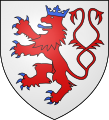Duchy of Berg
This article needs additional citations for verification. (March 2013) |
County (Duchy) of Berg | |||||||||
|---|---|---|---|---|---|---|---|---|---|
| 1101–1815 | |||||||||
|
Left: Arms of Bergins (from around 1225), who ruled the Duchy of Berg last Right: Coat of arms of the Duke of Berg | | ||||||||
• 1360–1380 | Wilhelm II (first duke) | ||||||||
• 1809-1813 | Napoléon Louis Bonaparte (Grand Duke) | ||||||||
| Historical era | Electorate of the Palatinate | 1609 and 1690 | |||||||
• Awarded to Prussia | 9 June 1815 | ||||||||
| |||||||||
Berg was a state—originally a county, later a duchy—in the Rhineland of Germany. Its capital was Düsseldorf. It existed as a distinct political entity from the early 12th to the 19th centuries.
The name of the county lives on in the modern geographic term Bergisches Land, often misunderstood as bergiges Land (hilly country).
History
Ascent
The Counts of Berg emerged in 1101 as a junior line of the dynasty of the
In 1160, the territory split into two portions, one of them later becoming the
The power of Berg grew further in the 14th century. The
Problems of succession

In 1509,
However, the new ducal dynasty also became extinct in 1609, when the last duke died insane. This led to a lengthy dispute over succession to the various territories before the partition of 1614: the
French revolution, Grand Duchy of Berg

The French occupation (1794–1801) and annexation (1801) of Jülich (French: Juliers) during the
In 1809, one year after Murat's promotion from Grand Duke of Berg to
Province of Jülich-Cleves-Berg
In 1815, after the Congress of Vienna, Berg became part of a province of the Kingdom of Prussia: the Province of Jülich-Cleves-Berg. In 1822 this province united with the Grand Duchy of the Lower Rhine to form the Rhine Province.
Rulers of Berg


House of Ezzonen
- Count Palatine of Lotharingia
- Adolf I of Lotharingia, Vogt of Deutz
- Adolf II of Lotharingia, Vogt of Deutz
House of Berge
- 1077–1082 Adolf I of Berg, 1st Count of Berg
- 1082–1093 Adolf II of Berg-Hövel (Huvili), Count of Berg
- 1093–1132 Adolf III, Count of Berg
- 1132–1160 Adolf IV, Count of Berg
- c.1140-1148 Adolf V, Count of Berg
- 1160–1189 Engelbert I, Count of Berg
- 1189–1218 Adolf VI, Count of Berg
- 1218–1225 Engelbert II of Berg, Archbishop of Cologne, Regent of Berg
- 1218–1248 Irmgard, heiress of Berg, marries in 1217 Henry IV, Duke of Limburg
House of Limburg
- 1218–1247 Henry IVDuke of Limburg, Count of Berg
- 1247–1259 Adolf VII Count of Limburg, Count of Berg
- 1259–1296 Adolf VIII
- 1296–1308 William I
- 1308–1348 Adolf IX
House of Jülich(-Heimbach), Counts
– in union with Ravensberg –
- 1348–1360 Gerhard
- 1360–1380 Wilhelm II; became duke in 1380
House of Jülich(-Heimbach), Dukes
– in union with Ravensberg (except 1404–1437) and after 1423 in union with the duchy of Jülich –
- 1380–1408 William I
- 1408–1437 Adolf
- 1437–1475 Gerhard
- 1475–1511 Wilhelm II
House of La Marck, Dukes
– from 1521 a part of the United Duchies of Jülich-Cleves-Berg–
- 1511–1539 Johann
- 1539–1592 William III
- 1592–1609 Johann Wilhelm I
House of Wittelsbach, Dukes
– in union with
- 1614–1653 Wolfgang Wilhelm
- 1653–1679 Phillip Wilhelm
- 1679–1716 Johann Wilhelm II
- 1716–1742 Karl Phillip
- 1742–1799 Karl Theodor
- 1799–1806 Maximilian Josef
- 1803–1806 William of Palatinate-Zweibrücken-Birkenfeld-Gelnhausen, Duke in Bavaria (administrator)
French Grand Dukes

- 1806–1808 Joachim Murat
- 1808–1809 Napoléon Bonaparte[5]
- 1809–1813 Napoléon Louis Bonaparte (under the regency of Napoléon Bonaparte)
Coat of arms
The historic coat of arms of Berg shows a red lion with a double tail and blue crown, tongue, and claws – blazoned as: Argent a lion rampant gules, queue fourchée crossed in saltire, armed, langued, and crowned azure. This lion originates from the arms of the Duke of Limburg as the Berg title in the 13th century fell to the Limburg line.
-
Heraldic shield of arms
See also
- List of consorts of Berg
- Aachen fine cloth
References
- ISBN 978-9004102620.
- ISBN 978-0814623879.
- ISBN 978-1277123517.
- ^ Encyclopædia Britannica: or, A dictionary of arts, sciences, and miscellaneous literature, enlarged and improved, Volume 3. Google e-books. 1823. p. 570.
- ^ Napoleon's decree in his quality of Grand Duke of Berg in Intelligenz-Nachrichten, June 24, 1809 (Stück XXV), pp. 341–342. Göttinger Digitalisierungszentrum.
External links
 Media related to Duchy of Berg at Wikimedia Commons
Media related to Duchy of Berg at Wikimedia Commons- Lwl.org: Edicts of Jülich, Cleves, Berg, Grand Duchy Berg, 1475–1815 (Coll. Scotti)
- Hoeckmann.de: Historical Map of Northrhine-Westphalia in 1789






